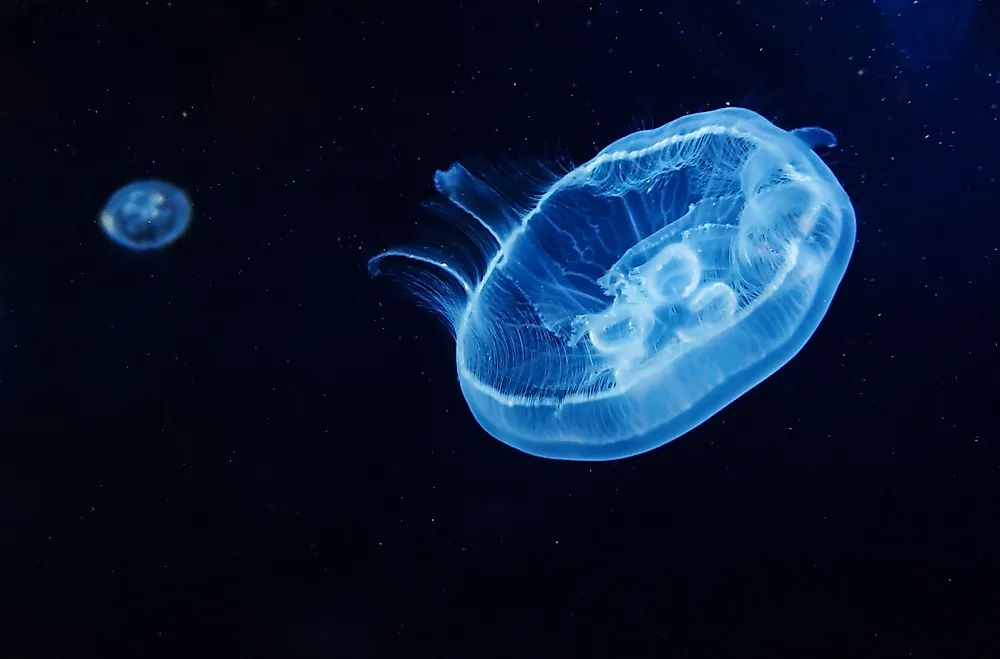Moon Jellyfish Facts: Animals of North America

5. Physical Description
The Moon Jellyfish, its scientific name being Aurelia aurita, is commonly found in groups or what are known as 'smacks' in coastal areas all over the world. Although it is virtually impossible to distinguish the many different subspecies of this organism without extensively studying their DNA, they are all characterized by the appearance of four reproductive organs, or 'gonads', which are each shaped like a horseshoe, and which can be clearly seen through their single, transparent 'bells' that dominate their respective body shapes. Small tentacles line their bodies' circumferences, while oral arms drape from their centers, serving the functions for primarily being used during feeding. The individual size of a given mature moon jelly can vary considerably, typically ranging between 2 and 15 inches in diameter.
4. Diet
The moon jelly is composed mainly of water, which in fact accounts for 95% of its entire body composition. It is a carnivorous animal, which is to say that it feeds on other protein-rich aquatic animals. Its menu includes minute plankton, fish eggs, and larval crabs and shrimp. A moon jelly does not use feet or a tail for locomotion. Instead, it moves through pulsations carried out within its bell, or through passively riding the seas' currents wherein they live. The minute animals that it feeds on are oftentimes stung by the moon jelly’s stinging cells (or nematocysts), which are commonly found lining its tentacles. Others get entangled in the lining of their ensnared prey, which is then transported along the Moon Jellyfish's internal canals, ultimately depositing all of the food into its stomach.
3. Habitat and Range
Moon Jellies may be found anywhere where there is sea water with temperatures of between 48 and 66 degrees Fahrenheit, although they have been found to also survive in waters with temperatures as low as 21 degrees, or as high as 88 degrees Fahrenheit. They can thrive in waters with a mixture of salt and fresh water (brackish water), although their bell may appear flattened in these conditions due to the lower concentrations of salt. They are commonly found in the cooler waters of North America and Europe, specifically along the coasts of New England and Canada. Experts have recorded a marked increase in the population of moon jellies over the last couple of decades, which is attributed to preceding drops in the populations of several species of their natural predators due to climate change and overfishing. Other threats to their survival include bacterial infections, which can be detrimental to their already vulnerable physical states.
2. Behavior
Among the many predators of moon jellies are larger fish species, birds commonly found along sea shores, other, larger jelly species, and sea turtles. A moon jelly adult may live for more than 12 months, while their polyp can go on living without their bodies for up to two and a half decades. At present, there are no real threats to the moon jelly population. While some may inflict stings that can be fatal to humans, generally they are very mild, and not considered dangerous at all. They tend to do rather well living in captivity, so long as they are provided with the right conditions. These conditions, of course, include an abundant supply of brine shrimp and other smaller aquatic animals that they can feed upon.
1. Reproduction
Moon jellies reproduce during the Summer, when the females give up their eggs, and the males release their sperm into the sea in intervals of 24 hour periods. This behavior demands a lot of energy, and usually will kill the jellies off in the process. In the wild, one can only expect these organisms to live for around half a year, and dying soon after they’ve reached adulthood.











